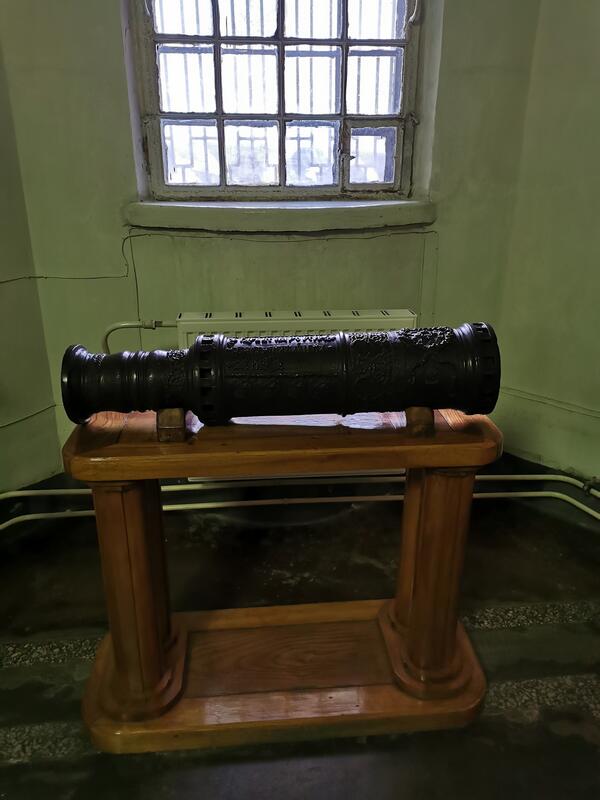The field howitzer of Master Ignatius is one of the two oldest, dated bronze guns cast in Russia by a Russian master. This barrel entered the museum in 1778 from the Moscow Cannon’s Court.
The word howitzer comes from the Czech “houfnice” cannon — a gun that could be loaded with stones or iron shot. In the 15th–18th centuries, weapons were manufactured using the method of “slow molding”. First, a mold was made: a cone-shaped core (a rod) was wrapped in straw and covered with clay in several layers. The clay for the lower layers was mixed with crushed brick, and for the upper layers — with wool and horse manure. Each time the mold was thoroughly dried in the open. Often the upper layer made of a mixture of wax, lard and crushed charcoal was soft, as ornaments and inscriptions were carved on it. When the last layer was applied, the wooden template was substituted for the model of a support frame in the form of a half-profile of the gun barrel. The models for dolphins (handles) were made of the lard-wax mixture as well. Wooden trunnions were nailed to the mold in the designated places. The form for the rear of the gun (the rounded part at the end of the breech) was made separately. When the fake mold was ready, the jacket or the upper flask was formed. The mold was coated with vegetable oil and lard, and covered with a mixture of clay, horse manure and split horsehair. Each layer was dried until the jacket acquired the desired thickness (it ranged from 17.5 to 30 cm). The same mixture was used to cover the holes in those places from which the wooden trunnions were removed. Then the structure was reinforced with iron strips, wire and rings. When the mold was completely dry, the core and the fake mold were removed from it, thus, the imprint of the barrel with the applied images was inside the jacket. The barrel was then connected to the breech.
The jacket was placed vertically in the foundry pit. A new core with a diameter of the gun caliber was placed inside. It functioned as a mold for the finished bore. Finally, bronze was poured into the mold.
The decorative elements of this howitzer are characteristic of the Renaissance period. From the breech to the muzzle there are five friezes featuring a floral pattern and images of a bouquet, branches, a lion, a vase, two wreaths, and ribbons. There are two paired deer on the muzzle. The inscriptions on the gun are quite concise and to the purpose, they indicate the year of casting, the name of the ruling tsar (or Grand Duke) and the name of the master.
The manufacturing process took many months, and the mold had to be broken every time to extract the finished barrel. Therefore, each barrel was unique.
The word howitzer comes from the Czech “houfnice” cannon — a gun that could be loaded with stones or iron shot. In the 15th–18th centuries, weapons were manufactured using the method of “slow molding”. First, a mold was made: a cone-shaped core (a rod) was wrapped in straw and covered with clay in several layers. The clay for the lower layers was mixed with crushed brick, and for the upper layers — with wool and horse manure. Each time the mold was thoroughly dried in the open. Often the upper layer made of a mixture of wax, lard and crushed charcoal was soft, as ornaments and inscriptions were carved on it. When the last layer was applied, the wooden template was substituted for the model of a support frame in the form of a half-profile of the gun barrel. The models for dolphins (handles) were made of the lard-wax mixture as well. Wooden trunnions were nailed to the mold in the designated places. The form for the rear of the gun (the rounded part at the end of the breech) was made separately. When the fake mold was ready, the jacket or the upper flask was formed. The mold was coated with vegetable oil and lard, and covered with a mixture of clay, horse manure and split horsehair. Each layer was dried until the jacket acquired the desired thickness (it ranged from 17.5 to 30 cm). The same mixture was used to cover the holes in those places from which the wooden trunnions were removed. Then the structure was reinforced with iron strips, wire and rings. When the mold was completely dry, the core and the fake mold were removed from it, thus, the imprint of the barrel with the applied images was inside the jacket. The barrel was then connected to the breech.
The jacket was placed vertically in the foundry pit. A new core with a diameter of the gun caliber was placed inside. It functioned as a mold for the finished bore. Finally, bronze was poured into the mold.
The decorative elements of this howitzer are characteristic of the Renaissance period. From the breech to the muzzle there are five friezes featuring a floral pattern and images of a bouquet, branches, a lion, a vase, two wreaths, and ribbons. There are two paired deer on the muzzle. The inscriptions on the gun are quite concise and to the purpose, they indicate the year of casting, the name of the ruling tsar (or Grand Duke) and the name of the master.
The manufacturing process took many months, and the mold had to be broken every time to extract the finished barrel. Therefore, each barrel was unique.





